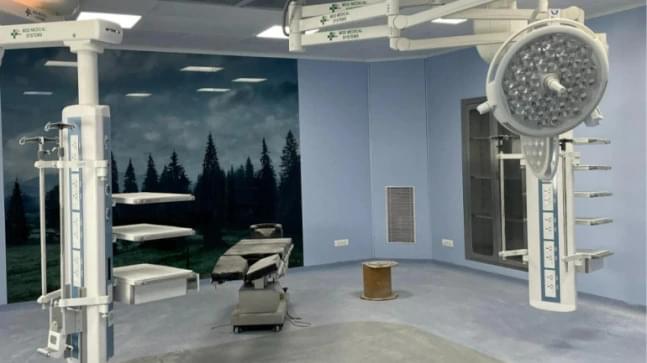NIA-funded researchers identified areas of the genome responsible for accelerating or slowing down brain aging.



While the OPD has been thrown open to the people, work is going on war footing as PM Modi is expected to inaugurate the hospital early next month. The hospital already has 25 transport ventilators from the PM CARES fund.
Any person coming for treatment will only have to pay Rs 10 in registration charges for a lifetime and there are nominal charges for treatment.
AIIMS Bilaspur is set up with the objectives of correcting regional imbalances in the availability of affordable/reliable tertiary healthcare services and also to augment facilities for quality medical education in the country.


One of the larger SpaceX disasters was eight months ago, a Falcon 9 was heavily damaged in rough high seas and there was a question of whether it would fly again. It was enough of a problem that SpaceX changed their landings to the Caribbean instead of the Atlantic Ocean during the winter to avoid high seas. (This reduced the amount of payload the rocket could support.)
Well, the rocket is going to fly again tomorrow as the 4th flight in a streak of at least 7 consecutive Starlink launches. SpaceX is launching faster and faster as their need for Starlink launches grows. They are hiring more technicians so they can launch faster from their 3 Falcon 9 launch towers.
SpaceX rolled a Falcon 9 rocket to its launch pad at Cape Canaveral and test-fired its engines Thursday, prepping for liftoff Saturday night carrying another group of Starlink internet satellites into orbit. The Falcon 9 booster has been repaired after a rough recovery in December knocked it out of SpaceX’s rocket reuse rotation.
The 229-foot-tall (70-meter) rocket fired up its nine Merlin 1D engines at 9:10 a.m. EDT (1310 GMT) Thursday on Space Launch Complex 40 at Cape Canaveral Space Force Station. The engines ignited for about seven seconds, ramping up to 1.7 million pounds of thrust as hold-down restraints kept the Falcon 9 firmly on the ground.
SpaceX loaded a million pounds of densified kerosene and liquid oxygen propellants into the Falcon 9 during the final 35 minutes of the mock countdown Thursday. The Falcon 9 was already stacked with its payload of more than 50 Starlink internet satellites during the static fire test.

Mark Zuckerger has confirmed on The Joe Rogan Experience podcast that Meta will be releasing its next virtual reality headset in October. While he didn’t mention a product name, he described a device that’s consistent with previous reports about the headset that’s codenamed “Project Cambria.” He said the company will likely launch it around its annual Connect event, which took place in late October last year.
According to a previous report by The Information, Reality Labs employees described the new headset as “laptop for the face” or “Chromebook for the face.” It will reportedly have outward-facing cameras enabling mixed-reality experiences. Also, the publication said back then that it will have the capability to allow users’ avatars in the metaverse to mirror their expressions and to show where they’re looking in real life.
As The Verge notes, Zuckerberg has also confirmed those features during his guesting. He said the headset’s features allow some kind of eye contact in virtual reality and that it will be able to translate users’ expressions in real time to their avatars, whether they’re smiling, frowning or pouting.
Given the potential scope and capabilities of quantum technology, it is absolutely crucial not to repeat the mistakes made with AI—where regulatory failure has given the world algorithmic bias that hypercharges human prejudices, social media that favors conspiracy theories, and attacks on the institutions of democracy fueled by AI-generated fake news and social media posts. The dangers lie in the machine’s ability to make decisions autonomously, with flaws in the computer code resulting in unanticipated, often detrimental, outcomes. In 2021, the quantum community issued a call for action to urgently address these concerns. In addition, critical public and private intellectual property on quantum-enabling technologies must be protected from theft and abuse by the United States’ adversaries.
https://urldefense.com/v3/__https:/www.youtube.com/watch?v=5…MexaVnE%24
There are national defense issues involved as well. In security technology circles, the holy grail is what’s called a cryptanalytically relevant quantum computer —a system capable of breaking much of the public-key cryptography that digital systems around the world use, which would enable blockchain cracking, for example. That’s a very dangerous capability to have in the hands of an adversarial regime.
Experts warn that China appears to have a lead in various areas of quantum technology, such as quantum networks and quantum processors. Two of the world’s most powerful quantum computers were been built in China, and as far back as 2017, scientists at the University of Science and Technology of China in Hefei built the world’s first quantum communication network using advanced satellites. To be sure, these publicly disclosed projects are scientific machines to prove the concept, with relatively little bearing on the future viability of quantum computing. However, knowing that all governments are pursuing the technology simply to prevent an adversary from being first, these Chinese successes could well indicate an advantage over the United States and the rest of the West.
Researchers use artificial intelligence to translate brain waves from fMRI into photos. Quantum computing breakthrough requires very little data to train AI. New deep learning framework for robotic arm art.
AI News Timestamps:
0:00 New AI Turns Brain Waves Into Photos.
3:24 Quantum Computing AI Breakthrough.
6:01 Deep Learning Robotic Arm.
👉 Crypto AI News: https://www.youtube.com/c/CryptoAINews/videos.
https://www.researchgate.net/publication/357660687_Hyperreal…tent_space.

Engineers at MIT have developed a new battery design using common materials – aluminum, sulfur and salt. Not only is the battery low-cost, but it’s resistant to fire and failures, and can be charged very fast, which could make it useful for powering a home or charging electric vehicles.
Lithium-ion batteries have dominated the field for the last few decades, thanks to their reliability and high energy density. However, lithium is becoming scarcer and more expensive, and the cells can be hazardous, exploding or bursting into flames if damaged or improperly used. Cheaper, safer alternatives are needed, especially as the world transitions towards renewable energy and electric vehicles.
So the MIT team set out to design a new type of battery out of readily available, inexpensive materials. After a search and some trial and error, they settled on aluminum for one electrode and sulfur for the other, topped off with an electrolyte of molten chloro-aluminate salt. Not only are all of these ingredients cheap and common, but they’re not flammable, so there’s no risk of fire or explosion.

When some materials are cooled to a certain temperature, they lose electric resistance, becoming superconductors.
In this state, an electric charge can course through the material indefinitely, making superconductors a valuable resource for transmitting high volumes of electricity and other applications. Superconductors ferry electricity between Long Island and Manhattan. They’re used in medical imaging devices such as MRI machines, in particle accelerators and in magnets such as those used in maglev trains. Even unexpected materials, such as certain ceramic materials, can become superconductors when cooled sufficiently.
But scientists previously have not understood what occurs in a material to make it a superconductor. Specifically, how high-temperature superconductivity, which occurs in some copper-oxide materials, works hasn’t been previously understood. A 1966 theory examining a different type of superconductors posited that electrons which spin in opposite directions bind together to form what’s called a Cooper pair and allow electric current to pass through the material freely.
Including Charlie Kam, Dr. Aubrey deGrey, Valery Chuprin, Jose Cordeiro, Gennady Stolyarov, Joseph Kowalsky & Richard Daley.
Please share this event with someone that you care about.
Would you like to make a Donation to Perpetual Life? Your donations help us grow & improve our services. To donate, go to our website http://Perpetual.Life and use the PayPal button at the top right of the page. Thank you for your generous donations, we appreciate it immensely!
“Our task is to make nature, the blind force of nature, into an instrument of universal resuscitation and to become a union of immortal beings.“
- Nikolai F. Fedorov.
We hold faith in the technologies & discoveries of humanity to END AGING and Defeat involuntary Death within our lifetime.
Working to Save Lives with Age Reversal Education.